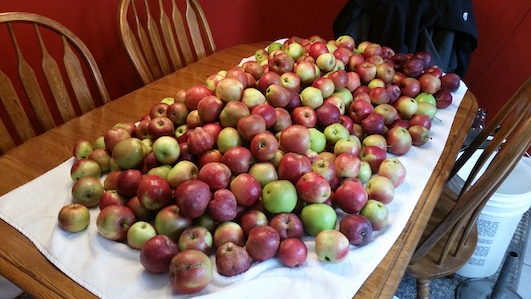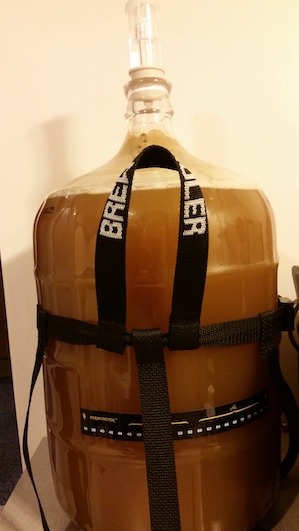Ok ok ok …. Yes cider!
I just made a cider (along with others) and we got to say a big thank you to fellow Manty Malter Scott Kohlmann for, once again, providing cider to the club via his uncle! And if you’ve ever processed apples for apple sauce, pie filling or juice … you know how much of a pain it is to process apples.
Click here to see how to do it: Let’s start with the numbers. YEAH MATH! So … press your own, order a special blend from the various orchards on our area or store bought cider WITHOUT preservatives. You’ll need apples! Orchards in the area (Yes there are TONS here are some): Now store bought cider (or from an orchard…) here what’s to look for and keep in mind. To SUFLITE or not to SULFITE … For those of you using fresh cider you’ll need kill bacteria and to control wild yeast naturally in the apples. Crush one campden tablet (potassium or sodium metabisulfite) for every gallon of cider. The same campden tablets you use in your brewing water for beer to remove chlorine and chloramine. Now this will not kill all bacteria or wild bugs in the must BUT will knock it down and keep to big bad ones at bay. Let it sit at least 24 hours and should be as good as it’s going to get. Now the ** D i s c l a i m e r ** Now one thing you’ll hear … and is NOT true. Let me make this absolutely clear … All alcoholic beverages dilate blood vessels in the brain and cause a headaches. Along with dehydration .. Histamines and tyramine in wines can contribute to the headaches .. but it’s the alcohol that’s causing that headache. Now that we’re through all that … time for a recipe! With a pound of sugar per gallon you’ll have a gravity around 1.085 to 1.090 (20.5 to 22 Brix/Plato) What I like to do (since you can also add but not take out) is the cut the: sugar, the acid blend and the tannin in half. Add the sugar to your desired original gravity before pitching your yeast. After fermentation gauge do you need more acid tartness? Do you need more tannin bite? Is it super hazy? What I do is take about 2 quarts of the must and combine all the ingredient addition and slower heat it all together. Now do not heat the entire batch, do not boil the mixture just heat enough to dissolve the sugar … no hotter then 160°F Like brewing … sanitation, sanitation, sanitation! Keep it clean people! And fermentation temp control … “Slow and low, that is the tempo..” Now you can follow a staggered nutrient plan like with meads. But fructose sugars in the apple must the yeast can chew through pretty easily. But if you do see a stuck or slow fermentation by all means add a slow amount of nutrients. Now … bottling, kegging, backsweeten, still or sparkling. So the low down for backsweeting … Potassium sorbate. Now up top … I said NO potassium sorbate. Now you can use potassium sorbate after fermenation is done. The will not kill the yeast but will stop the yeast from converting anymore sugars. Cider is super easy and don’t over think it … it’s dump and stir if you want it to be … or make it as complex as you want. Try malolactic fermentation, try a fruited cider, try an ice cider, try a cyser (mead with cider), try a Graf (cider-beer hybrid) … So many things to explore. So it has to be said.
(I know the math … but your yields will vary on your press and pressings)
Look for 100% juice NOT concentrate.
It will NEVER ferment
That is the question!
(Disclaimer down below)
Some people are touchy with sulfites / have a sensitivity to them. They are in LOTS of packaged and prepared foods. They can trigger asthma attack, hives, rashes and cramping. If you know for sure you or someone has this issues with a sulfite sensitivity … you’ll know! Then don’t use sulfites then. So skip the campden tablets and let the wild yeast go and do it’s thing!Sulfites do NOT cause headaches! Nor do tannins!
(Less or more … you decide)
I like D-47 71B for some extra flavor or EC-1118 for a neutral flavor
US-05, S-04 or “cider” yeasts …
Try them all!
During fermentation you’ll notice a very distinct smell … that’s the sulfur. Not like beer fermentation by any means. Smell that airlock you’ll know what I’m taking about.
Follow this link for more info: https://www.homebrewersassociation.org/how-to-brew/improve-mead-staggered-nutrient-additions/
Cider typically will not hold carbonation or have a head foamed like beer. Thus most ciders are served still. Your cider will finish bone dry … 1.000 or lower.
If you like to dry .. “Bob’s your uncle!” and you’re ready to go! Or time to add sugar back …
Do NOT add sugar and bottle or you’ll have kaboom! Bottle bombs are no joke.
Wait 24 hours after it is stirred in to halt the yeast
Dose in a know amount on the side to the gravity or taste you prefer and then scale up to your batch size. Or add to the entire batch in small amounts, thoroughly stir and then test






